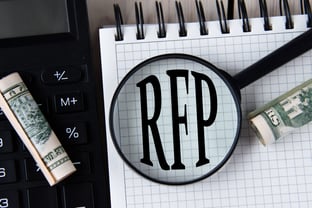Request for Proposal procurement (RFP procurement) is a structured method organizations use to solicit and evaluate competitive bids from vendors. The RFP procurement process creates transparency, maximizes competition, and ultimately secures the best value for the buyer.
An Office Supplies RFP From Start to Finish
To give you a concrete understanding of RFP, let's follow an RFP for office supplies.
Despite persistent predictions of "the paperless office" and pandemic-related challenges to office occupancy, the office supplies industry shows no signs of slowing. Analysts forecast it will grow to $32.08 billion by 2026, at a compound annual growth rate of 3.21%.
Almost every enterprise needs office supplies of some sort. How can your organization realize office supplies savings of money and time by using the RFP procurement process?
1. Define Clear Objectives
 Some RFPs focus on services or larger-scale projects. But an office supplies RFP involves procuring a diverse range of everyday essentials—stationery, furniture, equipment, technology, and more. It must consider requested items’ functionality, quality, and cost-effectiveness, as well as their compatibility with existing systems and infrastructure.
Some RFPs focus on services or larger-scale projects. But an office supplies RFP involves procuring a diverse range of everyday essentials—stationery, furniture, equipment, technology, and more. It must consider requested items’ functionality, quality, and cost-effectiveness, as well as their compatibility with existing systems and infrastructure.
Your office supplies RFP should clearly state your organization’s needs. List specific quantities, preferred brands, and any delivery or service requirements (for example, next-day shipping).
2. Develop a Comprehensive RFP Document
Your RFP document must let potential vendors provide a complete and accurate proposal. It typically includes such sections as:
- Overview of your organization
- Project objectives
- Scope of work
- Budgetary constraints
- Evaluation metrics
- Timeline and instructions for submitting bids
- Specific technical requirements, legal obligations, or terms and conditions to which bidders must adhere
Unlike RFPs seeking standardized products or services, office supply RFPs often require suppliers to customize offerings (for instance, branding, special packaging, or unique product configurations).
It should include a timeline for the procurement process and specify the proposal evaluation criteria you will use. It should note necessary legal and contractual requirements. Lastly, it should provide clear instructions on how to submit a proposal and the submission deadline.
3. Identify Potential Suppliers
 Market analysis helps you identify potential suppliers who can meet your needs. Utilize industry directories, trade fairs, and online databases to compile your list. Additionally, network with industry professionals, attend relevant conferences, and seek recommendations from other companies within your sector.
Market analysis helps you identify potential suppliers who can meet your needs. Utilize industry directories, trade fairs, and online databases to compile your list. Additionally, network with industry professionals, attend relevant conferences, and seek recommendations from other companies within your sector.
A well-prepared list of questions for potential vendors is critical. In our office supplies RFP example, you might ask suppliers to demonstrate capacity for handling ongoing, large-scale orders and maintaining consistent product availability. You'll also want to ask how they handle product substitutions.
As you're determining to whom you'll send your RFP, remember that inviting a diversified pool of bidders ensures a competitive process and increases your chances of finding your best-fit solution.
4. Distribute the RFP to Selected Bidders
Once you've identified prospective vendors, issue the RFP. You could directly email it, post it on a procurement portal, or advertise it in industry-specific publications.
Consider conducting a pre-bid conference or meeting before releasing the RFP. This gathering provides interested parties a chance to ask questions, seek clarifications, and gain a better understanding of your requirements.
5. Establish Your Evaluation Process
Bid evaluation criteria provide a clear framework for decision-making, enabling organizations to objectively evaluate bids and make informed choices.
Common bid evaluation criteria include:
- Price
- Technical competence
- Experience
- Quality
- Delivery time
- Financial stability
Once you've established your criteria, assign weights or scores to each criterion based on its relative importance. This weighting system helps calculate a score for each bid, allowing for a more objective and systematic evaluation.
In our RFP for office supplies example, note these items are generally lower value compared to large-scale projects or services. As a result, cost efficiency and competitive pricing become paramount. Seek suppliers who can offer attractive pricing structures, discounts, or bulk purchase arrangements. Even small savings per item can lead to significant office supplies savings.
6. Practice Due Diligence
Due diligence includes conducting reference checks, visiting vendor sites, and reviewing past performance. Seek evidence of a potential vendor's ability to meet the required standards and deliver a satisfactory outcome.
Once the evaluation is complete, you can move forward in the procurement process. You might conduct further negotiations with vendors, visit their sites, or request interviews and demonstrations if necessary.
7. Draft Contract Terms and Conditions
The contract with your selected vendor must clearly define the specific goods, services, or transactions the agreement covers. It should just as clearly outline payment terms, delivery schedules, and performance expectations. Be specific and concise when drafting these provisions to avoid ambiguity.
Include a section outlining indemnification and limitation of liability. This section protects both parties from unforeseen circumstances or damages that may arise during the course of the agreement. Also consider confidentiality and non-disclosure clauses, and a dispute resolution clause.
Review and revise the draft contract carefully. Seek legal counsel to ensure it includes all necessary elements. Make sure its terms and conditions are enforceable and comply with the laws and regulations governing the agreement.
Let CenterPoint Improve Your RFP Procurement Process
Practicing RFP procurement brings several benefits.
Vendors' increased competition for your business can lead to lower prices and better quality goods or services. This competition can result in better value, lower prices, more favorable terms, and overall cost savings.
Before you can benefit from an effective RFP procurement process, you need actionable insights about your procurement spend. Spend analysis lets you make informed decisions, optimize spending, identify areas for improvement, and achieve better outcomes in terms of cost savings, supplier performance, and overall procurement efficiency.
Request your free pricing analysis from CenterPoint Group today to help lay a firm foundation for successful RFP procurement.


Leave a Reply
Comment policy: We love comments and appreciate the time that readers spend to share ideas and give feedback. However, all comments are manually moderated and those deemed to be spam or solely promotional will be deleted.